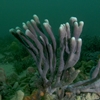General Description
A yellow to purple sponge species, stalked to cigar-shaped. Size of about 20 cm.
Biology
This species is common around the coast of Victoria and extends into New South Wales, South Australia and Tasmania.
Habitat
Sand and muddy areas, at depths of 10-85 m.
Sponge gardens
Soft substrates
Distribution guide
Australia.
Species Group
Depth
Shallow (1-30 m)
Deep ( > 30 m)
Water Column
Max Size
20 cm
Diet
Plankton or particles
Commercial Species
No
Global Dispersal
Native to Australia
Identify
Conservation Status
- DSE Advisory List : Not listed
- EPBC Act 1999 : Not listed
- IUCN Red List : Not listed





